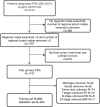Development and validation of lymph node ratio-based nomograms for primary duodenal adenocarcinoma after surgery
- PMID: 36276093
- PMCID: PMC9584089
- DOI: 10.3389/fonc.2022.962381
Development and validation of lymph node ratio-based nomograms for primary duodenal adenocarcinoma after surgery
Abstract
Background: The prediction models for primary duodenal adenocarcinoma (PDA) are deficient. This study aimed to determine the predictive value of the lymph node ratio (LNR) in PDA patients and to establish and validate nomograms for predicting overall survival (OS) and cancer-specific survival (CSS) for PDAs after surgical resection.
Methods: We extracted the demographics and clinicopathological information of PDA patients between 2004 and 2018 from the Surveillance, Epidemiology and End Results database. After screening cases, we randomly divided the enrolled patients into training and validation groups. X-tile software was used to obtain the best cut-off value for the LNR. Univariate and multivariate Cox analyses were used in the training group to screen out significant variables to develop nomograms. The predictive accuracy of the nomograms was evaluated by the concordance index (C-index), calibration curves, area under the receiver operating characteristic curve (AUC) and decision curve analysis (DCA). Finally, four risk groups were created based on quartiles of the model scores.
Results: A total of 978 patients were included in this study. The best cut-off value for the LNR was 0.47. LNR was a negative predictive factor for both OS and CSS. Age, sex, grade, chemotherapy and LNR were used to construct the OS nomogram, while age, grade, chemotherapy, the number of lymph nodes removed and LNR were incorporated into the CSS nomogram. The C-index, calibration curves and AUC of the training and validation sets revealed their good predictability. DCA showed that the predictive value of the nomograms was superior to that of the American Joint Committee on Cancer (AJCC) TNM staging system (8th edition). In addition, risk stratification demonstrated that patients with higher risk correlated with poor survival.
Conclusions: The LNR was an adverse prognostic determinant for PDAs. The nomograms provided an accurate and applicable tool to evaluate the prognosis of PDA patients after surgery.
Keywords: cancer-specific survival; lymph node ratio; nomogram; overall survival; primary duodenal adenocarcinoma.
Copyright © 2022 Shi, Liu, Cao, Shan, Zhang and Wang.
Conflict of interest statement
The authors declare that the research was conducted in the absence of any commercial or financial relationships that could be construed as a potential conflict of interest.
Figures






Similar articles
-
Prognostic Nomogram Based on the Metastatic Lymph Node Ratio for T1-4N0-1M0 Pancreatic Neuroendocrine Tumors After Surgery.Front Oncol. 2022 Apr 27;12:899759. doi: 10.3389/fonc.2022.899759. eCollection 2022. Front Oncol. 2022. PMID: 35574346 Free PMC article.
-
Dynamic nomograms combining N classification with ratio-based nodal classifications to predict long-term survival for patients with lung adenocarcinoma after surgery: a SEER population-based study.BMC Cancer. 2021 Aug 4;21(1):653. doi: 10.1186/s12885-021-08410-6. BMC Cancer. 2021. PMID: 34344326 Free PMC article.
-
Development and external validation of a novel nomogram for predicting cancer-specific survival in patients with ascending colon adenocarcinoma after surgery: a population-based study.World J Surg Oncol. 2022 Apr 19;20(1):126. doi: 10.1186/s12957-022-02576-4. World J Surg Oncol. 2022. PMID: 35439983 Free PMC article.
-
Developing and validating a prognostic nomogram for ovarian clear cell carcinoma patients: A retrospective comparison of lymph node staging schemes with competing risk analysis.Front Oncol. 2022 Nov 9;12:940601. doi: 10.3389/fonc.2022.940601. eCollection 2022. Front Oncol. 2022. PMID: 36439411 Free PMC article.
-
Evaluation of the association between lymph node ratio and long-term survival in patients after surgery for lymph node-positive bladder cancer: a SEER population-based study with external validation.BMC Cancer. 2025 Jan 23;25(1):135. doi: 10.1186/s12885-024-13384-2. BMC Cancer. 2025. PMID: 39849404 Free PMC article.
Cited by
-
Risk factors, prognostic factors, and nomograms for distant metastasis in patients with diagnosed duodenal cancer: A population-based study.World J Gastrointest Oncol. 2024 Apr 15;16(4):1384-1420. doi: 10.4251/wjgo.v16.i4.1384. World J Gastrointest Oncol. 2024. PMID: 38660656 Free PMC article.
-
Metachronous primary esophageal squamous cell carcinoma and duodenal adenocarcinoma: A case report and review of literature.World J Gastrointest Surg. 2023 Nov 27;15(11):2627-2638. doi: 10.4240/wjgs.v15.i11.2627. World J Gastrointest Surg. 2023. PMID: 38111767 Free PMC article.
-
A 3 M Evaluation Protocol for Examining Lymph Nodes in Cancer Patients: Multi-Modal, Multi-Omics, Multi-Stage Approach.Technol Cancer Res Treat. 2024 Jan-Dec;23:15330338241277389. doi: 10.1177/15330338241277389. Technol Cancer Res Treat. 2024. PMID: 39267420 Free PMC article. Review.
References
LinkOut - more resources
Full Text Sources

